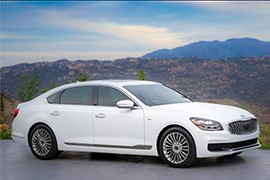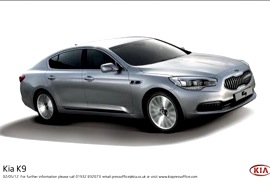KIA K9 Models/Series Timeline, Specifications & Photos
First production year: 2012
Engines: Gasoline
If the Stinger was considered a beautiful sedan, the K900 was definitely better than it. The K9 was fully redesigned for 2019 and we could say it was the enlarged Stinger’s brother.
The exterior of the K9 was rather friendly than aggressive, with standard full LED headlights and the already standard Kia grille – the producer said that the grille was designed to look like it’s made of diamonds.
Looking to the side, we could notice how big the K9 really was, however, the back was a combination between a Mercedes and a Bentley; a beautiful one, nevertheless.
The back also featured dual exhausts and a single led reverse light.
If the exterior was not that out of the ordinary, things changed with the interior.
The interior of the K9 was the true definition of luxury, with soft touch materials, leather, piano black and wood inserts.
In the center of the dashboard we could find a designer analogue clock. Does that ring a bell? Mercedes?
The power seats had 12-way orr 14-way adjustments and were both heated and cooled.
A 17-speak audio system added to the luxurious sedan, with a crystal clear sound.
The 12-inch touchscreen display ran extremely smooth and could have also been control by using the command control knob.
The downsides of the K9? No doors soft close, no massage seats. Wait. A starting price of $59.900 – that is pretty average for a luxury car!
Kia introduced the K9 as its flagship model in 2012 on the Korean market, and later on, it took it to other markets, including U.S., Canada, Russia, and Middle-East.
While the Europeans were crying for the luxurious Korean sedan, other customers were happy with the badge-engineered Hyundai Equus and Genesis. Kia took its gloves off and tried to make it into the premium segment with the K9, also known as K900, to the States customers.
A rear-wheel-drive Kia was unusual, but that was what the K9 was. Its LED headlights with aggressive styling and the signature "tiger-nose" grille made it look important, even though it didn't have the same stance as a premium German vehicle. On the sides, the car featured two vents on the front fenders. The overall cab-rearward design emphasized the rear-wheel-drive architecture, with a pushed-back C-pillar and a short trunk lid.
Inside, Kia installed everything it got in its R&D department. Apart from the luxurious leather-wrapped interior, it loaded the car with tons of technology, including soft-close doors, bird-eye-view around the vehicle, head-up display, and the infotainment system that could have been controlled by the rear-seat passengers as well. In the instrument panel, Kia dropped the analog dials and installed a large TFT display. For the American equivalent, the K900, the Korean luxury sedan came equipped with analog dials.
Under the hood, the K9 featured a direct-injected 3.8-liter gasoline engine. It sent the power to the rear wheels via an eight-speed automatic transmission.

